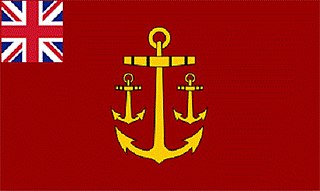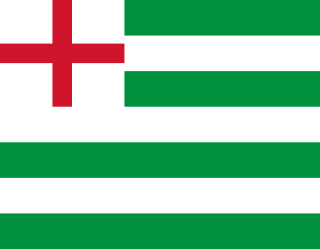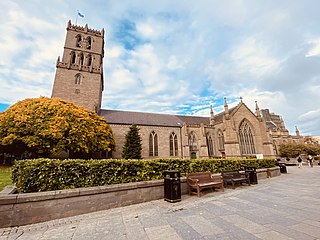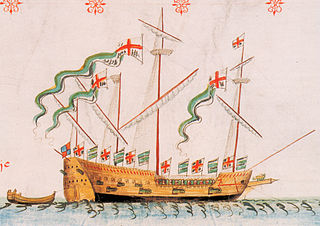
Henry Grace à Dieu, also known as Great Harry, was an English carrack or "great ship" of the King's Fleet in the 16th century, and in her day the largest warship in the world. Contemporary with Mary Rose, Henry Grace à Dieu was even larger, and served as Henry VIII's flagship. Built by William Bond under the direction of Robert Brygandine, she had a large forecastle four decks high, and a stern castle two decks high. She was 165 feet (50.29 m) long, measuring 1,000 tons burthen and having a complement of 700 men. She was ordered by Henry VIII, probably to replace Grace Dieu, which had been destroyed at the Battle of Saint-Mathieu in August 1512, and at a time of naval rivalry with the Kingdom of Scotland, her size was in response to the Scottish ship Great Michael, which had herself been the largest warship when launched in 1511.

The Treasurer of the Navy, originally called Treasurer of Marine Causes or Paymaster of the Navy, was a civilian officer of the Royal Navy, one of the principal commissioners of the Navy Board responsible for naval finance from 1524 to 1832. The treasurer was based at the Navy Pay Office.

The Battle of Pinkie, also known as the Battle of Pinkie Cleugh, took place on 10 September 1547 on the banks of the River Esk near Musselburgh, Scotland. The last pitched battle between Scotland and England before the Union of the Crowns, it was part of the conflict known as the Rough Wooing and is considered to have been the first modern battle in the British Isles. It was a catastrophic defeat for Scotland, where it became known as "Black Saturday". A highly detailed and illustrated English account of the battle and campaign authored by an eyewitness William Patten was published in London as propaganda four months after the battle.

The First Siege of Boulogne took place from 19 July to 14 September 1544 and the Second Siege of Boulogne took place in October 1544.

The Bishop's Palace, Kirkwall is a 12th-century palace built at the same time as the adjacent St Magnus Cathedral in the centre of Kirkwall, Orkney, Scotland. It housed the cathedral's first bishop, William the Old of the Norwegian Catholic church who took his authority from the Archbishop of Nidaros (Trondheim). The ruined structure now looks like a small castle.

The Tudor navy was the navy of the Kingdom of England under the ruling Tudor dynasty (1485–1603). The period involved important and critical changes that led to the establishment of a permanent navy and laid the foundations for the future Royal Navy.

The Antelope was a ship of the English Tudor navy, launched in 1546. She was rebuilt three times, in 1558, 1581 and 1618. She thus served in various forms from the time of King Henry VIII to the English Civil War. She is mostly remembered for being a part of the fleet that defeated the Spanish Armada.

The Steeple Church occupies the western part of the historic "City Churches" building in Dundee, Scotland. It is a congregation of the Church of Scotland.

Richard Brooke or Broke bought the manor of Norton, near Runcorn, Cheshire from Henry VIII in 1545 following the dissolution of the monasteries. The manor included the former monastery of Norton Priory and also the settlements of Norton, Stockham, Acton Grange and Aston Grange in Cheshire and Cuerdley in Lancashire.

Peter Pomegranate was a warship of the English Tudor navy, built in 1510. Her name most likely was in honour of Saint Peter and the badge of Queen Catherine of Aragon, a pomegranate.
Mary Willoughby was a ship of the English Tudor navy. She appears in the navy lists from 1532 during the reign of Henry VIII. She was named after Maria Willoughby, a lady-in-waiting and close friend of Catherine of Aragon. The ship was taken by the Scots in 1536 and was included in the Royal Scots Navy, The English recaptured her in 1547. The ship was rebuilt in 1551, increasing in size from 140 bm to 160 bm.
Patrick Gray, 4th Lord Gray was a Scottish landowner and Sheriff of Angus, active during the war of the Rough Wooing as a supporter of the Scottish Reformation.

Sir Andrew Dudley, KG was an English soldier, courtier, and diplomat. A younger brother of John Dudley, 1st Duke of Northumberland, he served in Henry VIII's navy and obtained court offices under Edward VI. In 1547–1548 he acted as admiral of the fleet and participated in the War of the Rough Wooing in Scotland, where he commanded the English garrison of Broughty Castle. He was appointed captain of the fortress of Guînes in the Pale of Calais in late 1551. There he got involved in a dispute with the Lord Deputy of Calais, which ended only when both men were replaced in October 1552.

Salamander was a warship of the 16th-century Royal Scots Navy. She was a wedding present from Francis I of France to James V of Scotland.
The Inventory of Henry VIII compiled in 1547 is a list of the possessions of the crown, now in the British Library as Harley MS 1419.
Sir John Clere was an English politician and naval commander.
Lieutenant Admiral Sir William Woodhouse was an English naval commander and administrator who rose to the rank of Lieutenant of the Admiralty and was head of the Council of the Marine later called the Navy Board. He also served as a Member of Parliament of the Parliament of England from 1545 to 1564. He was prominent during an important time of the Navy Royal's development in the later half of the Tudor period.

The Admiral of the Narrow Seas also known as the Admiral for the guard of the Narrow Seas was a senior Royal Navy appointment. The post holder was chiefly responsible for the command of the English navy's Narrow Seas Squadron also known as the Eastern Squadron that operated in the two seas which lay between England and Kingdom of France and England and the Spanish Netherlands later the Dutch Republic from 1412 to 1688. His subordinate units, establishments, and staff were sometimes informally known as the Command of the Narrow Seas.
Admiral Sir John Malyn or Malen, was a seaman, shipowner and later senior officer of the English Navy Royal who served under Henry VIII, Edward VI and Mary I. He died at sea off the coast of Rye, East Sussex, England whilst in command of his ship HMS Grehound that was wrecked after hitting an unseen sandbar.

The North Sea Squadron was a temporary naval formation of the Tudor Navy Royal during the sixteenth century operating out of Newcastle, England.













